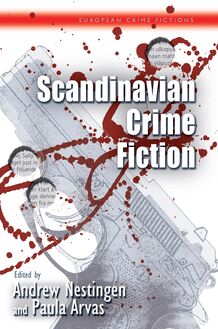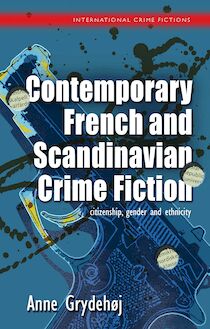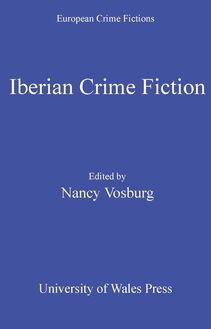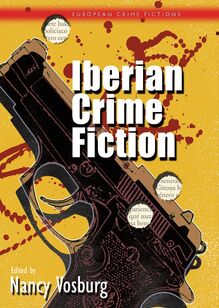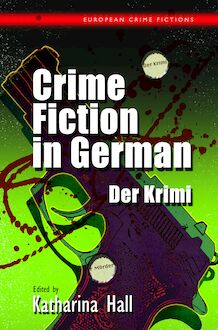Iberian Crime Fiction , livre ebook
88
pages
English
Ebooks
2011
Vous pourrez modifier la taille du texte de cet ouvrage
Obtenez un accès à la bibliothèque pour le consulter en ligne En savoir plus
Découvre YouScribe en t'inscrivant gratuitement
Découvre YouScribe en t'inscrivant gratuitement
88
pages
English
Ebooks
2011
Vous pourrez modifier la taille du texte de cet ouvrage
Obtenez un accès à la bibliothèque pour le consulter en ligne En savoir plus
Publié par
Date de parution
15 février 2011
Nombre de lectures
2
EAN13
9781783164493
Langue
English
Iberian Crime Fiction is the first volume in English to provide an extensive overview of crime fiction in Spain and Portugal. While the origins of peninsular crime fiction are traced in Nancy Vosburg's introductory chapter to the volume, the essays focus on specific topics that provide readers with a sense of the development of the genre in the second half of the 20th-century and current trends in the 21st-century. Patty Hart, whose The Spanish Sleuth introduced English-speaking readers to early crime fiction in Spain, provides a summary account of the development of the crime novel from the 1950s through the 1980s, highlighting the major authors and works that set the stage for the boom that followed the establishment of the novela negra tradition in the 1970s. This tradition, spearheaded by Manuel Vazquez Montalban, is the subject of a separate essay by Maria Balibrea that analyzes the socio-political conditions that gave rise to the novela negra. NancyVosburg studies the emergence of a feminine/feminist crime novel in the 1980s and 1990s and the subversion of masculine codes associated with crime fiction, while Stewart King analyzes crime fiction from the Catalan, Basque, and Galician autonomous regions of Spain, focusing on the political realities that resulted in a different use of the genre as a vehicle of regional nationalism. David Knutson traces contemporary trends in Spanish crime fiction, beginning in the 1990s and up to the present. Paul Castro's essay documents the emergence of crime fiction in Portugal and the major works/authors through to the present.
Publié par
Date de parution
15 février 2011
Nombre de lectures
2
EAN13
9781783164493
Langue
English
Series Editors Claire Gorrara (Cardiff University) Shelley Godsland (University of Birmingham) Giuliana Pieri (Royal Holloway, London)
Editorial Board Margaret Atack (University of Leeds) George Demko (Dartmouth College) John Foot (University College London) Stephen Knight (Cardiff University) Nickianne Moody (Liverpool John Moores University) Elfriede Müller (Berlin) Anne White (University of Bradford)
EUROPEAN CRIME FICTIONS
IBERIAN CRIME FICTION
Edited by
Nancy Vosburg
© The Contributors, 2011
All rights reserved. No part of this book may be reproduced in any material form (including photocopying or storing it in any medium by electronic means and whether or not transiently or incidentally to some other use of this publication) without the written permission of the copyright owner except in accordance with the provisions of the Copyright, Designs and Patents Act 1988. Applications for the copyright owner’s written permission to reproduce any part of this publication should be addressed to The University of Wales Press, 10 Columbus Walk, Brigantine Place, Cardiff, CF10 4UP.
www.uwp.co.uk
British Library Cataloguing-in-Publication Data A catalogue record for this book is available from the British Library.
ISBN 978-0-7083-2332-8 e-ISBN 978-1-78316-449-3
The right of the Contributors to be identified separately as authors of this work has been asserted by them in accordance with sections 77 and 79 of the Copyright, Designs and Patents Act 1988.
Cover design: Olwen Fowler Cover illustration: Brett Breckon.
Contents
1 Introduction to Iberian Crime Fiction Nancy Vosburg
2 Crime Fiction since the Spanish Civil War Patricia Hart
3 In Search of a New Realism: Manuel Vázquez Montalbán and the Spanish Novela Negra Mari Paz Balibrea
4 Detecting Difference/Constructing Community in Basque, Catalan and Galician Crime Fiction Stewart King
5 Spanish Women’s Crime Fiction, 1980s–2000s: Subverting the Conventions of Genre and Gender Nancy Vosburg
6 Spanish Crime Fiction: 2001 and Beyond David Knutson
7 Five Cases from 130 Years of Portuguese Detective Fiction, 1870s–2000s Paul M. Castro
1
Introduction to Iberian Crime Fiction
NANCY VOSBURG
Murder, mayhem and criminal acts of all varieties have been present in the literature of the Iberian Peninsula since its earliest inception (reflected in the twelfth-century epic poem Cantar de Mío Cid , for instance), but crime fiction, or género policíaco , as we know it today, does not arise on the peninsula until the mid-nineteenth century, a few years after Edgar Allen Poe published ‘Murders in the Rue Morgue’ (1841) and when a police force identifiable as such was created in Spain. While Spanish Romantic writers such as the Duque de Rivas, with his ‘Una antigüalla de Sevilla’ (1843, A Seville Antique), and José Zorrilla, with ‘Un testigo de bronce’ (1845, A Bronze Witness), experimented with crime fiction in verse, Pedro Antonio de Alarcón is generally credited with writing the first crime story in Spain, the 1853 El clavo (The Nail). 1 As the story begins, it appears to be a tale of unrequited love between the magistrate/detective, Zarco, and a mysterious woman named Blanca. 2 By the time a murder is discovered, readers anticipate that Zarco’s investigation will inevitably lead him back to Blanca, who drove a nail through her previous husband’s head. The story is narrated by his friend and companion, Felipe, who has flashes of intuition that foreshadow the outcome. While readers are in the know about ‘who done it’ because of the way the narrative is set up, Alarcón’s story nevertheless presents the logical steps that Zarco takes in his investigation, making it an early precursor to the modern detective novel. The story also includes an interesting twist, unusual for its time, as the magistrate/ detective discovers his own role in the chain of events, which forces him to assume some of the responsibility for the crime.
After the 1887 appearance of the British sleuth Sherlock Holmes in A Study in Scarlet , imitative works abounded in Spain in penny novels and melodramas. 3 But the genre received a literary boost when the grande dame of Spanish narrative at the turn of the century, Doña Emilia Pardo Bazán, wrote a detective novella, La gota de sangre (1911, The Drop of Blood), featuring the amateur sleuth Señor Selva. The protagonist, a wealthy, bored dandy and a suspect in a murder that has occurred outside his home, keeps one step ahead of the local police force when he investigates and solves the crime in order to prove his own innocence. One of the most interesting aspects of this novella is the depiction of the institutional police force, which is shown to be backward, unscientific and thus incapable of carrying out a rigorous murder investigation, a theme which, as Hart documents, recurs even in contemporary detective fiction and is particular to Spain. 4 Additionally, the novella is innovative in its metafictional aspects, as Señor Selva, an avid reader of detective fiction, engages in frequent self-reflection about his actions and methods. 5 And, perhaps most important of all, Pardo Bazán seems much more interested in exploring the motives for the crime than in the means by which the detective discovers the murderer.
Despite the impetus given to the genre by the renowned Pardo Bazán, crime novels were still considered a low-brow form of literature and publicly disdained or dismissed by writers and intellectual readers in Spain in the early decades of the twentieth century. There were a handful of penny novels featuring Spanish sleuths in the 1920s and 1930s, although translations of the British ‘cozy’ mysteries were more popular. The Catalan novelist Mercè Rodoreda published Crim , a parody of the English cozy novel, in 1936, which suggests that she already considered crime fiction a dead genre. Yet, even during the Spanish Civil War (1936–9), three detective novels set in Spain and featuring a Spanish police inspector named Venancio Villabaja were written by E. C. Delmar (pseudonym of Julian Amich Bert): El misterio del contador (The Mystery of the Book-keeper), Piojos grises (Gray Lice) and La tórtola de la puñalada (The Stabbed Turtle Dove). 6 In general, the detective novels of this period, including Delmar’s, were imitative of the British cozy mysteries or reworkings of American and English plots.
In Portugal, detective fiction started even more slowly than in Spain, and as Paul Castro points out in his chapter in this volume, was essentially born in parody. Portugal’s greatest naturalist/realist writer, Eça de Queiroz, co-wrote with Ramalho Ortigão O Mistério da Estrada de Sintra (The Sintra Road Mystery), published in 1870 and considered the first Portuguese detective novel. As Castro notes in his chapter, ‘ O Mistério was essentially designed as a hoax. It was, therefore, the first instance of the playfulness that has often characterized the detective fiction genre in Portugal.’
Despite the relatively late appearance of detective fiction in Spain and Portugal, as compared with Great Britain, France and the US, crime fiction enjoys a great popularity in contemporary Iberian literature, with crime novels often topping the best-seller lists in both countries. In this volume, the contributors, all of whom have published articles or books on Iberian crime fiction and have participated in international conferences on the topic, have attempted to identify and explain the high points in the development of the genre, while simultaneously exploring the ways in which the crime novel serves as a vehicle for exploring issues of national concern.
Patricia Hart of Purdue University was the first Hispanist to publish a volume in English on Spanish detective novels, The Spanish Sleuth , in 1987 . In chapter 2, she considers the somewhat late appearance of crime fiction in Spain. She traces the development of the crime novel as it began to pick up more literary impetus in the 1950s, primarily with the works of Mario Lacruz. Her essay provides an overview of the development of Spanish crime fiction from Lacruz’s El inocente (1953, The Innocent) to the 1990s.
In chapter 3, Mari Paz Balibrea, of Birkbeck College, University of London, focuses specifically on the novela negra , the Spanish manifestation of the hard-boiled detective novel made popular in the US from the 1930s to the 1950s by such authors as Dashiel Hammett and Raymond Chandler. As Balibrea shows, Manuel Vázquez Montalbán, with twenty-three novels in his Pepe Carvalho series, is considered Spain’s greatest practitioner of the novela negra phenomenon. He was the most significant and most influential writer of the genre from the 1970s until his death in 2003.
In chapter 4, Stewart King of Monash University in Australia explores the ways in which detective fiction in the Spanish autonomous regions with their own distinct languages (Catalonia, Galicia and the Basque Country) is used as a vehicle to promote national identity in these regions and to explore their unique cultural differences compared with the Castilian-dominated centre. King has chosen a representative author from each of the three autonomous regions to demonstrate the concerns of writers from the peripheral regions of Spain.
Nancy Vosburg, of Stetson University in the US, dedicates chapter 5 to the emergence of a large body of women’s crime fiction which began in 1980s Spain. As Vosburg reveals in her analyses of women’s crime fiction, issues of gender in the masculine-dominated crime genre become of paramount importance as women writers challenge the assumptions of both genre and gender in a rapidly changing society. The chapter also underscores the ways in which women’s crime fiction gives us a measure of women’s status, and the obstacles they continue to face, in the new egalitarian nation.
David Knutson of Xavier University completes the study of Spanish crime fiction in chapter 6 with his essay on contemporary tre
